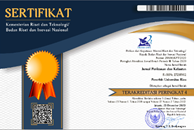Identification of Pathogenic Bacteria from Striped Catfish (Pangasionodon hypophthalmus) kept in Aquaculture Ponds
(1) Jurusan Budidaya Perairan Universitas Riau
(2) universitas Riau
(3) Universitas Riau
(*) Corresponding Author
Abstract
Koto Masjid Village is the largest production center in striped catfish fish farming activities in Riau Province. One of the inhibiting factors is the disease caused by bacteria, this study aims to determine the types of pathogenic bacteria that have the potential to infect striped catfish. This research was conducted in August - November 2019, samples of striped catfish used in the study amounted to 15 tails with an average length of 15-25 cm taken from 5 ponds in Kampung II, Koto Masjid Village, XIII Koto Kampar Subdistrict, and then identified bacteria by Conventional Laboratory in Fish Parasites and Diseases, Faculty of Fisheries and Marine, Riau University, Pekanbaru. This study uses a survey method that is by taking samples from the field in Pu and then the isolation of bacteria is carried out from the kidney organ in the TSB media then purified on the TSA media. The results of the study found 3 types of pathogenic bacteria namely Aeromonas sp., Edwardsiella sp., and Pseudomonas sp. Water quality during the study was pH 6.6-70, DO 4.05-4.35 mg/L, NH3 0.035-0.2 mg/L and Temperature 28-300C.
Keywords
Full Text:
PDFReferences
Anonim. 2017. Info Pertanian. Tersedia : http://www. Infopertanianku.com [3 Januari 2020]
Aryani, N., H. Syawal, I. Lukisyowati, dan M. Riauwaty. 2017. Parasit dan Penyakit Ikan. Jilid 2. Unri Press, Pekanbaru. 114 hlm
Austin, B., dan D.A. Austin. 2007. Aeromonadaseae Representatives (Aeromonas salmonicida). In: Bakterial Fish Pathogens: Disease in Farmed and Wild Fish, 4th Ed. Chichester, UK. Praxis Publishing Pp:24-314.
Bergey’s. 1994. Manual of Determinative Bacteriology. Ninth Edition. A mawerly Company.
Bruno, D.W. dan B.P. Wood. 1999. Saprolegnia and Other Oomycetes. In:Woo PTK & Brun DW, editor : Fish Diseases and Disolder vol.3, Viral, Bakteri dan Fungal Infektions. CABI publishing, Walling ford, Owon, Unitid Kingdom : 560-569.
Cowan, S.J. 1974. Cowan dan Steel’s Manual for Identification of Medical Bacteri. 2nd Ed. Cambridge University Press. Cambridge.
Effendi H. 2003. Telaah Kualitas Air Bagi Pengelolaan Sumberdaya dan Lingkungan Perairan. Yogyakarta: Kanisius.
Hadzqi, I., H. Saberina, dan Syafriadiman. 2018. Analisis Total Solid Kolam Tanah PMK dengan Umur 1-20 Tahun yang dipelihara Ikan Jambal Siam (Pangasius hypophthalmus) secara Intensif. Jurnal Online Mahasiswa Fakultas Perikanan dan Kelautan Universitas Riau.
Holt. J.G., et al. 2000. Bergey’s Manual DeterminativeBacteriology. Baltimore: Williamn and Wilkins Baltimore
Irianto, A. 2005. Patologi Ikan Teleostei. Gadjah Mada University Press, Yogyakarta.
Kordi, K.M.G. 2010. Budidaya Ikan Jambal Siam di Kolam Terpal. Lily Publisher. Yogyakarta. 98 hlm.
________. 2005. Pengelolaan Kualitas Air dalam Budidaya Perairan. Rineka Cipta. Jakarta.
________. 2004. Penanggulangan hama dan penyakit Ikan. Cetak pertama. Jakarta : PT Rineka Cipta.
Lukistyowati, I dan Feliatra. 2019. Teknik Isolasi dan Identifikasi Escherichia coli dan Bakteri Patogen pada Ikan. Unri Press Pekanbaru. 61 hlm.
Lukistyowati, I. dan Kurniasih. 2012. Pelacakan Gen Aerolysin dari Aeromonas hydrophila pada Ikan Mas yang Diberi Pakan Ekstrak Bawang Putih. Pekanbaru. Jurnal Veteriner, 13(1): 1-8.
Lusiastuti, AM., T. Sumiati, Wartono, H., Sularto dan Taukhid. 2012. Studi Kasus Super Infeksi Aeromoniasis Terhadap Edwardsiellosis Pada Benih Patin di Kabupaten Subang, Jawa Barat. Prosiding Forum Inovasi Teknologi Akuakultur.
Naibaho, FF., D. Suryanto, dan R. Leidonal. 2017. Jenis-jenis Bakteri Potensial pada Ikan Jambal Siam (Pangasius sp.) di Kolam Budidaya Ikan Air Tawar Kota Beling Tanah Air Kecamatan Tanjung Anom Provinsi Sumatra Utara. Jurnal Manajemen Perikanan.
Narwiyani, S., dan Kurniasih. 2011. Phylogenetic Tree dari Empat Isolat Edwardsiella Tarda di Indonesia. Biota 16(2) : 348-353.
Park, SB., T. Aoki, and T.S Jung. 2012. Pathogenesis and Strategies for Preventing Edwardsiella tarda infections in Fish. Veterinary Reasearch, 43:46.
Sakazaki, R. 1967. Studies on the Asakusa Group of Enterobaktericeace (Edwarsella tarda). J. med.Scl. Biol., 20: 205-212.
Sarono, A., HN. Kammiso, I.Y.B. Lelono, Widodo, Nuzirwan, T., E. B. S. Haryani, S. Haryanto, Tryanto, Ustadi. A. N. Kusumahati, W. Novianti, S. Wardani dan Setianingsih. 1993. Deskripsi Hama dan Penyakit Ikan Karantina Golongan Bakteri. Pusat Karantina Pertanian. Jakarta. 90 hlm.
Susanto, H. 2009. Pembenihan dan Pembesaran Patin. Penebar Swadaya. Jakarta
Wakayashi, H., and S. Egusa. 1973. Edwardsiella tarda (Paracolobatrum anguillimortiferum) Associated with Pond Cultured Ell Diseases. Bull. Japanese Soc. Scien Fish. 39:931-936.
Wyatt, L.E., R. Nickelson, and C. Vanderzant. 1979. Edwardsiella tarda in Freshwater Catfish and their Environment. Applied and Enveronment Microbiology, 38: 710-714.
Article Metrics
Abstract view : 290 timesPDF - 843 times
DOI: http://dx.doi.org/10.31258/jpk.26.1.40-46
Copyright (c) 2021 Jurnal Perikanan dan Kelautan

This work is licensed under a Creative Commons Attribution-NonCommercial-NoDerivatives 4.0 International License.
Gedung Marine Center Lt 2. Fakultas Perikanan dan Kelautan Universitas Riau



